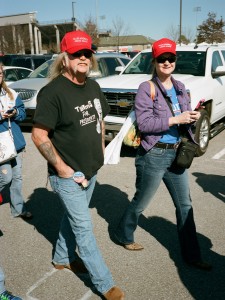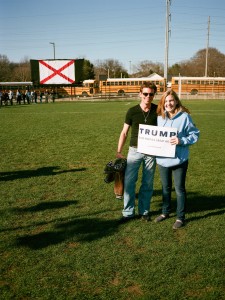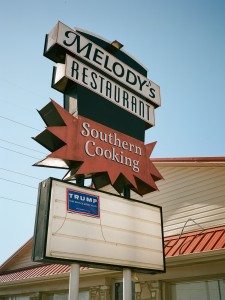KENDALL GILBERT and what attending a Donald Trump rally taught him about free speech.
I arrived in Alabama at the height of the U.S. primary season. Donald Trump had just earned his second victory, defeating Republican rivals Ted Cruz and Marco Rubio in South Carolina. His focus was now shifting to Alabama, Georgia, Texas, and a slew of other states voting on March 1. Trump’s rise to the top surprised everyone. He had seemingly done all the wrong things a candidate could do, but he kept winning. Like much of the country, I was fascinated. With time on my hands and a desire to capture the moment in pictures, I took a trip to Madison, Alabama where I’d see a Trump rally firsthand.
Trump’s campaign seemed to become more controversial as it went along. He attacked his political opponents labeling them ‘lyin’ Ted’ and ‘little Marco,’ and in speeches, Trump lambasted women, Muslims, and immigrants. He encouraged his supporters to act violently toward protestors, telling them he would cover any legal fees that should arise. His rallies were becoming more a spectacle of abuse and violence than a stage for political dialogue. Yet, his style was vindicated at the polls where he ably defeated career politicians in places he had little experience in.

The news media was left scrambling to understand Trump’s appeal. Most pundits failed to predict his rise, much less explain how it was possible. Many outlets focused on Trump under the pretense that the media had failed to properly vet him. Before attending his rally in Madison Alabama, revelations about Trump’s relationship with David Duke, the white supremacist and former K.K.K. Grand Wizard were published. While the media could not explain how he was winning, journalists could shed light on Trump’s past. But were voters listening? Or was the media just another ‘corrupt’ institution for Trump to attack?
If you were in Madison, Alabama on February 28, you might have thought there was a high school football game happening, rather than a political rally. In line outside the stadium, I found myself alongside Dads with their daughters, Grandma’s holding lawn chairs, and groups of men tailgating in the parking lot. Not exactly the kind of crowd you’d expect to incite violence, but these were Trump voters–predominantly white, middle aged homeowners, who have families. They were welcoming despite the cameras around my neck, and seemed at ease while I freely snapped pictures. Many were quick to express why they thought Hillary was a criminal and how Trump would make a great president.
At first glance, I found it difficult to understand how they could support a hardheaded New York rich guy. After all, Trump made a business practice of cutting corners and gaming the system. His supporters were hard working taxpayers, model Republicans you might say. The problem was these folks were not reaping the benefits they were promised. They had been squeezed so hard by a failing Republican Party and a bold Obama presidency, that they felt they had nowhere to turn to but Trump.
Once inside the rally, I weaved through the crowd, looking for subjects that stood out. Problem was, there were great shots all around me. A ‘Hillary for Prisonment’ sign here, a Confederate Battleflag there, white dudes wearing those ‘Make America Great Again’ T-shirts all over the place. I had to be discerning to capture anything good. I snapped a few portraits and eventually made my way to the corner of the field where Trump was set to enter from.
After some waiting and much anticipation, the speakers cut to ‘Sweet Home Alabama’ and Trump stepped onto the field amid a swarm of police and bodyguards. The crowd was amped. Many rushed to the guardrail hoping catch a glimpse of the man as he made his way toward the podium. I managed to fight my way above the iPhones, signs and fists to get a decent shot of Trump just as he stepped out on the grass.

On stage, Trump stood alongside Alabama Senator Jeff Sessions who gave Trump his full endorsement for president. The crowd loved it. And once Trump stepped to the mic, it seemed he could get away with anything. He attacked his political rivals, doubled down on controversial policies toward Muslims and reiterated his plans to build a wall along the Mexican border. His supporters cheered him every step of the way.
But not everyone present was in lockstep with Trump. Five minutes into the affair, a woman holding a homemade sign a few rows ahead of me had Trump demand she leave. Minutes later, a group of black university students with clenched fists held high were escorted out. And finally, a group of military veterans were ejected after opening a sign that read, ‘We stand with our Muslim brothers and sisters.’ In each case, Trump jeered, ‘Get ‘em outta here!’ to roars of approval from the crowd. And as the protestors made their way to the gate, some in the audience screamed profanities or made gestures at them.
Removing these protestors would have been illegal if the rally were held in a public space, but all Trump rallies were private events, giving him the power to restrict access to anyone he felt unwelcome. His campaign could even hire local police to instill a sense of legitimacy, and once a protestor caused enough a stir, the police could remove the individual under the guise of ‘order’.

Under this framework, Trump could have kicked journalists out as well. Instead, he just verbally attacked them. Halfway through his speech, Trump pointed to the press corps corralled in the middle of the stadium and said ‘they are so dishonest these reporters, they are the worst,’ going on to call the New York Times investigation into his relations with the KKK a ‘hit piece’. Almost on cue, many in the crowd turned their thumbs down toward the media and booed. And when Trump said he’d change libel laws that protected journalists from lawsuits, they applauded.
His supporters have given Trump the endorsement to say or do anything: he can encourage his supporters to commit violent acts whilst restricting the speech of those he disagreed with. The rally evidenced a twisted, backward reality, girded by an aura of power he had created for himself. Trump effectively put free speech on the stand in his own rigged trial, and to no one’s surprise, he won, expelling dissidents and shaming critics in the process.

In spite of the attacks against journalists and protestors, I left Trump’s rally enlightened. Before Madison, I had never felt my basic right to expression to be in question. I’d always had a platform for my views: I grew up playing music and using Myspace years before I ever picked up a camera or opened a Twitter account. Never before had I felt intimated at the prospect expressing myself. But Trump’s proceedings made it clear that although speech might be a right, it is a right guaranteed by those in power. No matter what kind of tradition or history a nation might have, no democracy is forever safe from turmoil and no right immune to denial.
I continued to speak after Donald Trump’s rally in Madison, Alabama, in a photo essay titled ‘The South in Votetime’, investigating Donald Trump’s rise, supporters and the implications a Trump presidency would have on the American dream. Regardless of what happens in tomorrow’s election, we can’t stop speaking out. There are many ways to hold leaders to account, we can use images and sounds as well as words. This becomes so much more important when leaders abuse their power: in Trump’s act of drowning out all voices that he doesn’t like, he poses a severe threat to freedom of speech. We need to speak back even more loudly.

All images are the author’s own.





